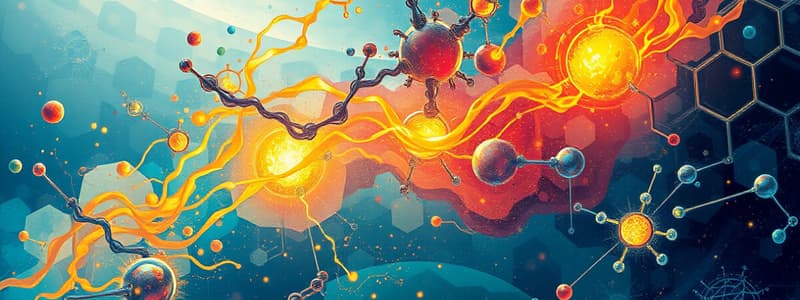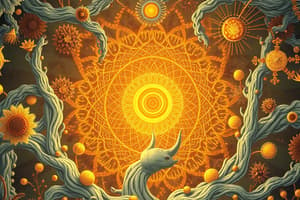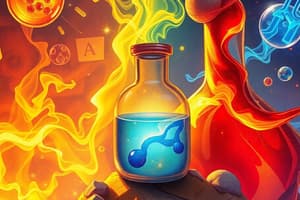Podcast
Questions and Answers
What is matter defined as?
What is matter defined as?
- Anything that can be perceived by the senses.
- Anything that takes up space and has mass. (correct)
- Anything that can change shape.
- Anything that exists in solid form.
Which statement accurately describes an element?
Which statement accurately describes an element?
- A substance that cannot be broken down into another substance. (correct)
- A substance that can be broken down into simpler substances.
- A compound formed from two or more different atoms.
- A variable composed of both atoms and molecules.
What is the smallest unit of an element that retains the element's characteristics?
What is the smallest unit of an element that retains the element's characteristics?
- Element
- Molecule
- Compound
- Atom (correct)
What does the Law of Conservation of Mass state?
What does the Law of Conservation of Mass state?
How are acids defined in relation to water?
How are acids defined in relation to water?
What pH value represents a neutral solution?
What pH value represents a neutral solution?
Which of the following correctly describes bases?
Which of the following correctly describes bases?
Which statement about atoms is true?
Which statement about atoms is true?
What term is used to describe organisms that produce their own food by absorbing sunlight?
What term is used to describe organisms that produce their own food by absorbing sunlight?
Which group has the lowest energy content and biomass in a terrestrial food web?
Which group has the lowest energy content and biomass in a terrestrial food web?
What percentage of energy is typically transferred to the next trophic level in a food chain?
What percentage of energy is typically transferred to the next trophic level in a food chain?
According to the second law of thermodynamics, what happens during the conversion of energy from one form to another?
According to the second law of thermodynamics, what happens during the conversion of energy from one form to another?
Which of the following specifically describes the relationship of energy loss in trophic levels?
Which of the following specifically describes the relationship of energy loss in trophic levels?
In a food web, what role do plants, algae, and cyanobacteria play?
In a food web, what role do plants, algae, and cyanobacteria play?
What key principle does the first law of thermodynamics illustrate regarding energy?
What key principle does the first law of thermodynamics illustrate regarding energy?
What is a consequence of the energy loss at each trophic level in food chains?
What is a consequence of the energy loss at each trophic level in food chains?
What is a phase change?
What is a phase change?
What describes kinetic energy?
What describes kinetic energy?
According to the First Law of Thermodynamics, what happens to energy?
According to the First Law of Thermodynamics, what happens to energy?
What is potential energy?
What is potential energy?
How does energy conversion efficiency relate to entropy?
How does energy conversion efficiency relate to entropy?
What do primary producers do in the food chain?
What do primary producers do in the food chain?
What is the effect of increasing entropy in a system?
What is the effect of increasing entropy in a system?
What role do primary consumers play in an ecosystem?
What role do primary consumers play in an ecosystem?
Flashcards are hidden until you start studying
Study Notes
Matter and Energy Overview
- Matter occupies space, has mass, and exists as solids, liquids, or gases.
- Elements are pure substances, like gold and calcium, that cannot be broken down.
- Atoms are the smallest units of elements retaining their properties.
- The Law of Conservation of Mass states that matter cannot be created or destroyed; mass remains constant during chemical reactions.
Chemical Reactions and Changes in Matter
- Matter can transition between states (solid, liquid, gas) through phase changes without altering its chemical structure.
- Chemical reactions can rearrange atoms into new molecules or chemical compounds.
- Gases can experience pressure changes due to molecule collisions within their container.
Understanding Energy
- Energy is the capacity to perform work, existing in forms such as mechanical, chemical, electrical, radiant, nuclear, and thermal.
- Kinetic energy refers to energy in motion, while potential energy is stored energy awaiting release.
Laws of Thermodynamics
- The First Law of Thermodynamics states energy cannot be created or destroyed, only transformed.
- The Second Law explains that energy transfers are never 100% efficient; energy degrades into heat, thus increasing entropy (system disorder).
Energy Flow in Ecosystems
- Trophic levels categorize organisms in the food chain:
- Primary producers (plants, algae, cyanobacteria) transform sunlight into chemical energy.
- Primary consumers feed on producers; only 10% of the energy from organic matter transfers to the next trophic level, leading to energy loss.
- Top carnivores hold the lowest energy content and biomass in terrestrial food webs.
Key Takeaways
- Matter is fundamentally composed of elements and atoms, governed by conservation principles.
- Energy powers living systems, characterized by different forms, with energy transfers resulting in efficiency losses.
- Understanding trophic levels and energy flow is essential for grasping ecological interactions and sustainability concepts.
Studying That Suits You
Use AI to generate personalized quizzes and flashcards to suit your learning preferences.




